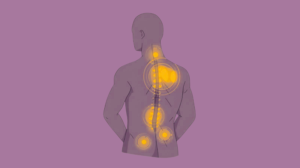Waking up with a stiff neck or back pain can destroy your day. You roll around in bed searching for comfort, and wake up worse off than you did the previous night. This is extremely prevalent in adults over the age of 30 who start to feel the beginning of poor sleeping posture and an unbalanced spine. What you don’t realize is that the offending item is your pillow. Contour cervical pillows are designed to activate spinal wellness, i.e., upper back and neck, and thus are a game-saver for healthy aging.
We all experiment with new mattresses, positions, or even medication to correct our sleeping problems, but the poor old pillow goes unnoticed. Your neck holds your head all day long, and if it’s not in the correct position at night, that stress then finds its way into the morning. A contour cervical pillow quietly works in the background as you sleep, getting you ready in the proper position to wake up feeling new, not stiff.
Why Does Spinal Alignment Matter as We Age?
The Impact of Poor Sleep Posture on Spinal Health
Improper sleeping posture places uneven stress on the spine, causing musculoskeletal tension and long-term pain. Improper head and neck alignment while sleeping significantly contributes to cervical disc degeneration and nerve impingement [1]. Our spine becomes increasingly susceptible to these stresses with age as our bones become less dense and our discs become dehydrated.
Poor sleeping posture also worsens imbalances caused by a sedentary lifestyle or habitual repetitive movement, once more pushing the spine out of position. This not only produces local pain but can result in radiating syndromes in arms, shoulders, and even the lower back.
Link Between Neck Pain, Aging, and Daily Function
Long-term neck pain is very prevalent among older individuals. Neck pain was ranked as one of the top causes of disability across the world by the Global Burden of Disease Study, particularly in older persons [2]. Degenerative changes like spondylosis, loss of muscle elasticity, and joint stiffness are more prominent as we age, so it becomes increasingly crucial to maintain spinal alignment during sleep.
Neck pain can debilitate the performance of daily activities like driving, employment, or even basic motions like neck rotation. A contour cervical pillow eases such conditions by providing structural support that maintains the cervical spine in a neutral position during sleep.
What Is a Contour Cervical Pillow?
Design and Structure Explained
A contour cervical pillow has been designed to mimic the natural shape of your head and neck. In contrast to flat or fluffy regular pillows, it has two sides that are elevated with a small indention in between. This contoured design supports the natural C-shape of the neck and aligns the head with the spine.
The elevated edges support the neck, and the middle recess supports the head but doesn’t support it forward or cause it to lean in an unnatural position. This feature reduces pressure points and allows natural sleeping posture, whether you are a back or side sleeper.
Differences from Traditional Pillows
Text pillows usually do not support the cervical spine well. They can be too soft, tilting the head and bending the neck, or too hard, bending the neck into an abnormal posture. In a 2020 review of the evidence, published in Healthcare (Basel), pillow shape and pillow height were found to be linked with sleep quality and spinal alignment [3].
Contour cervical pillows are designed to meet the one-of-a-kind needs of the neck, which regular designs fail to consider. Their contours are steady throughout the night to prevent compression and flattening typical of regular pillows.
Recommended Materials (e.g., Memory Foam)
Cervical pillows of good quality are mostly constructed of latex or memory foam. Memory foam molds to the shape of your neck and head, giving personalized support that resists losing shape. This material distributes weight evenly and eliminates pressure off the vertebrae and soft tissues.
Seek models with hypoallergenic, breathable tops and cooling gel pads to avoid overheating. There is evidence of the effect of memory foam in the support of spinal posture and decreased resting muscle activity [4].
What Are the Benefits of Using a Contour Cervical Pillow?
1. Promotes Natural Spine Curvature
Contour pillows support the natural shape of the cervical spine. It helps maintain the spinal structure and prevents over-arch or flattening of the neck curve, both of which would cause muscle tension or compression of the nerves. As per the Journal of Manipulative and Physiological Therapeutics, proper support by a pillow can improve cervical alignment and decrease musculoskeletal symptoms in the long run [5].
2. Reduces Neck and Shoulder Tension
By maintaining head, neck, and shoulders in a neutral alignment, contour pillows allow muscles to relax completely. This leads to decreased tension and decreased micro-contraction, thus decreased stiffness or soreness upon waking. In a randomized controlled trial presented in Physical Therapy Science, it was found that cervical pillows had considerable effects in decreasing neck and shoulder pain in adults with chronic pain [6].
3. Improves Sleep Quality and Cognitive Recovery
When your spine is in correct alignment during sleep, it shifts into deeper, more restorative levels of relaxation. Repeated turning and tossing is a consequence of incorrect alignment and interferes with sleep cycles. A supported spine enables greater glymphatic clearance (the brain’s waste-removal system), which is essential for thought process and mood regulation [7].
Sleep quality has a direct influence on memory, alertness, and emotional strength. Sleeping with a contour cervical pillow ensures uninterrupted sleep and leads to long-term intellectual well-being.
4. Supports Active Aging and Mobility
Improved sleeping position translates into fewer day pains, enabling more physical functioning and fewer falls. Sleeping in a spine-supportive position will maintain mobility, range of joint motion, and functional independence, generally, all of which are so important to the aging process.
Contour pillows may be particularly helpful for individuals age 50 and older who start feeling posture, bone strength, and joint comfort alterations.
How Can You Choose the Right Contour Cervical Pillow?
There are heights and sizes of contour pillows to match body types and sleeping positions. Opting for the proper height is important; too high, it stretches the neck into an unnatural position. Too low, and it doesn’t provide sufficient support.
Based on a clinical trial on BMJ Open Sport & Exercise Medicine, pillow height plays a significant role in cervical spine angle and user comfort [8]. Make sure the pillow supports the area between your head and shoulders without propping up your chin.
Sleeping Position and Pillow Compatibility
Back sleepers like lower in profile and support the head and neck. Side sleepers need higher on the edge to bridge across the shoulder to head, maintaining spine alignment. Stomach sleeping is not recommended but, if necessary, a very thin or no pillow is advised not to put extra rotation of the neck.
Choose a pillow according to your most used sleeping position to receive the maximum ergonomic support and spinal alignment.
When to Consult a Physiotherapist
In case you keep getting neck pain, headache, or numbness, approach a physiotherapist prior to choosing a pillow. He/she will evaluate your cervical posture, muscle tension, and hidden conditions, and then suggest a suitable cervical pillow.
Experts may also suggest other practices such as exercise, mattress adjustment, or physical therapy to optimize your sleeping conditions.
What Are the Real-Life Results of Aging Better with Spinal Support?
Testimonials from 30+ Adults Noticing Early Signs of Aging
Several adults in their 30s and 40s have reported that they feel less stiff, fewer headaches, and improved concentration after changing to a contour cervical pillow. These changes typically appear within weeks and are a sign of improved sleeping posture and relaxation of the muscles.
Frequent users experience improved productivity, lower dependency on painkillers, and overall wellness. These advantages weigh in favor of early prevention over waiting for pain to be debilitating.
Preventive Care vs. Reactive Treatment
Dependence on pain-developed medication, massage, or chiropractic treatment alone is a reactive process. A contour cervical pillow is a daily, easy preventive treatment.
Research indicates that long-term spinal support eliminates the need for more invasive therapies and helps to offer independence, especially as mobility diminishes due to age.
How Do Contour Pillows Fit into a Holistic Aging-Wellness Routine?
Cervical pillows are automatically integrated in physiotherapeutic care programs for patients suffering from whiplash, cervical spondylosis, or postural dysfunction. The pillows complement manual therapy as well as stretching by aiding the maintenance of correct spine alignment in day-to-day life outside the clinic.
They are also used as a maintenance aid to avoid the relapse of symptoms, thus an integral component of long-term prevention of pain.
Integration with Betterhood’s Daily Practices
At betterhood, we are advocates for preventive wellness. Having a contour cervical pillow as part of your daily habit is a small but powerful one that enhances mobility, sleep, and well-being. Combined with ergonomic products, healthy movement habits, and body awareness, this pillow is an essential element of our aging-well model.
Betterhood stands for proper awareness and education concerning spinal health so that aging is not as much a breakdown but more an expertly supported experience.
Frequently Asked Questions:
1. Can a contour cervical pillow relieve chronic neck pain?
Yes. These pillows are designed to support the cervical curve, which helps reduce strain on muscles and discs. Clinical studies confirm reductions in pain levels among users with chronic symptoms.
2. How long does it take to adjust to a cervical pillow?
Most people adapt within 5 to 10 days. Mild soreness may occur initially as muscles adjust to the improved posture, but this usually subsides quickly.
3. Is memory foam the best material for cervical pillows?
Memory foam is widely recommended for its pressure-relieving properties and ability to conform to the body’s shape. It maintains consistent support and resists flattening over time.
4. Should I use a cervical pillow if I sleep on my stomach?
Stomach sleeping is not ideal for neck health, but if necessary, use a very thin pillow or none at all to minimize cervical rotation and strain.
References
- https://www.jstage.jst.go.jp/article/jpts/29/9/29_jpts-2017-274/_article
- https://www.thelancet.com/action/showPdf?pii=S0140-6736%2815%2960804-1
- https://www.mdpi.com/2227-9032/8/2/243
- https://www.ncbi.nlm.nih.gov/pmc/articles/PMC8339313/
- https://www.jmptonline.org/article/S0161-4754(02)00067-1/fulltext
- https://www.jstage.jst.go.jp/article/jpts/31/5/31_jpts-2018-064/_article
- https://www.ncbi.nlm.nih.gov/pmc/articles/PMC6500450/
- https://bmjopensem.bmj.com/content/6/1/e000792























